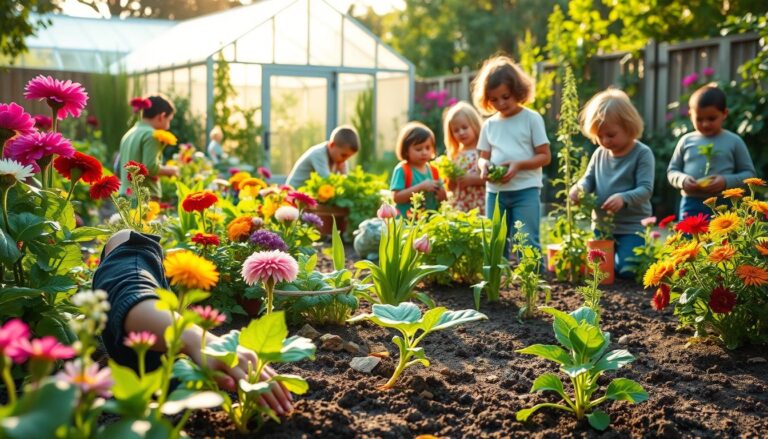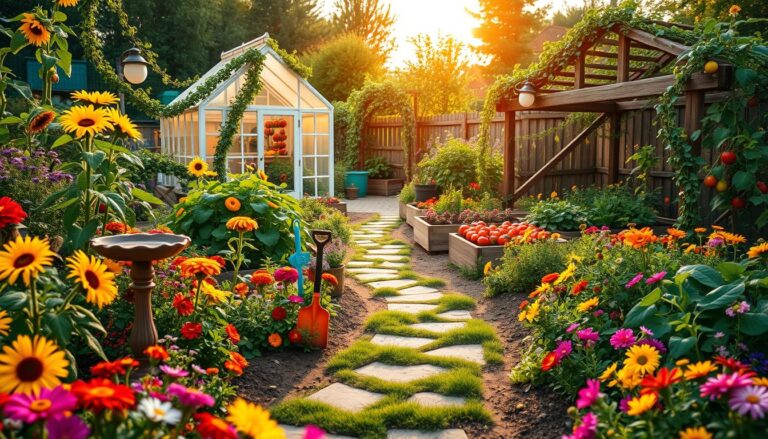Creating a garden that attracts bees and butterflies is a joy to see. It also helps the local ecosystem a lot. By adding pollinator-friendly plants to your garden, you give these important creatures what they need to do well.
Attracting pollinators to your garden is easy. Just pick plants that are full of nectar and pollen. This helps the bees and butterflies and makes your garden look great too.
By creating a pollinator garden, you help the environment and enjoy a healthy ecosystem.
The Vital Role of Pollinators in Our Ecosystem
Pollinators are the unsung heroes of our ecosystem. They are key for many plants to reproduce. Their work affects our environment and daily lives in big ways.
Why Pollinators Matter for Food Production
Pollinators like bees, butterflies, and hummingbirds are vital for food. One-third of the food we eat depends on them. They help grow fruits, veggies, nuts, and seeds. Without them, we’d face food shortages and economic losses.
| Crop | Pollinator Dependency |
|---|---|
| Apples | High |
| Almonds | Very High |
| Blueberries | High |
The Declining Pollinator Population Crisis
Pollinators are facing big threats. Habitat loss, pesticide use, and climate change are main reasons. This crisis affects food security and ecosystem health. We need to create pollinator-friendly habitats with nectar and pollen plants.
Understanding pollinators’ importance is key. By supporting them, we can tackle the crisis. This ensures our ecosystem’s health.
Understanding Different Types of Pollinators
The world of pollinators is vast and varied. It includes many species vital for our planet’s health. These creatures help many plants reproduce, keeping our ecosystem healthy.
Bees: The Premier Pollinators
Bees are key pollinators, with over 20,000 species worldwide. They pollinate a big part of the world’s crops, like fruits, veggies, and nuts. Efficient pollinators, bees love flowers with bright colors and strong scents.
Butterflies and Moths: Colorful Pollination Partners
Butterflies and moths are also vital pollinators. Their colorful looks and many species add to ecosystems’ richness. Though not as efficient as bees, they pollinate certain plants, like those with long, tube-shaped flowers.
Other Important Pollinators: Hummingbirds, Bats, and Beetles
Other creatures also play big roles in pollination. Hummingbirds love flowers with bright colors and rich nectar. Bats are key in tropical and desert areas. Beetles visit flowers with strong, fruity scents.
To help pollinators, create a pollinator-friendly landscape. Plant a variety of plant species for pollinators. This helps your local ecosystem’s health and biodiversity.
- Plant a diverse range of flowers that attract different pollinators.
- Avoid using pesticides, which can harm or kill pollinators.
- Provide shelter and nesting sites for pollinators.
Benefits of Creating a Pollinator-Friendly Garden
Pollinator-friendly gardens are great for the environment and your outdoor space. They help local ecosystems and provide a safe place for vital creatures. By creating such a garden, you’re making your area healthier and more beautiful.
Environmental Impact of Supporting Pollinators
Creating a garden for pollinators has a big positive environmental impact. Pollinators are key for many plants to reproduce. Your garden helps them pollinate, which is good for fruits, veggies, and plants that keep ecosystems healthy.
“The fate of pollinators is closely tied to the fate of our planet. By supporting pollinators, we are supporting the health of our ecosystems and our food supply.”
Personal Benefits: Better Harvests and Beautiful Gardens
A pollinator-friendly garden is good for you too. It attracts more pollinators, leading to better harvests. Plus, it makes your garden look amazing and lively, making your outdoor space even better.
Contributing to Biodiversity Conservation
Creating a pollinator-friendly garden helps with biodiversity conservation. By planting different flowers, you support various pollinators. This keeps plant species diverse and helps the local food chain.
| Benefit | Description | Impact |
|---|---|---|
| Environmental Support | Aids in pollination and ecosystem health | High |
| Personal Benefits | Better harvests and garden aesthetics | Medium |
| Biodiversity Conservation | Supports genetic diversity and local ecosystems | High |
Essential Pollinator-Friendly Plants for Your Garden
Turning your garden into a haven for pollinators starts with the right plants. A well-planned garden attracts bees and butterflies and boosts the ecosystem’s health. By adding a variety of pollinator-friendly plants, you make your garden vibrant and sustainable, supporting local biodiversity.
Flowering Herbs: Lavender, Mint, and Oregano
Flowering herbs are great for any pollinator-friendly garden. Lavender with its purple blooms is a hit with bees and butterflies. Mint is also a favorite, but it needs careful control to prevent it from spreading too much. Oregano is another good choice, offering nectar for pollinators.
Classic Blooms: Coneflowers, Black-Eyed Susans, and Sunflowers
Coneflowers, Black-Eyed Susans, and sunflowers are key in a pollinator-friendly garden. They’re not just beautiful but also rich in nectar and pollen for bees and butterflies. Plus, they’re easy to grow and care for, making them great for all gardeners.
“Planting a variety of flowers that bloom at different times can provide a constant source of nectar and pollen for pollinators throughout the growing season.”
Flowering Shrubs: Butterfly Bush, Blueberry, and Serviceberry
Flowering shrubs like butterfly bush, blueberry, and serviceberry are great for attracting pollinators. The butterfly bush is especially good for butterflies. Blueberry and serviceberry offer nectar and fruit, benefiting many pollinators.
By adding these essential pollinator-friendly plants to your garden, you create a welcoming space for bees, butterflies, and other beneficial insects. This not only makes your garden more beautiful and biodiverse but also helps the local ecosystem’s health.
Native Pollinator-Friendly Plants by Region
To support your local ecosystem, choose native plants that fit your area’s climate and soil. These plants have evolved with local pollinators, offering them nectar, pollen, and host plants. Your garden will become a haven for a variety of pollinators.
Northeast Native Plant Selections
The Northeast has cold winters and warm summers. Great plants for this area include Black-eyed Susans (Rudbeckia hirta), Butterfly Weed (Asclepias tuberosa), and Joe-Pye Weed (Eutrochium maculatum). They’re not just pretty; they’re also vital for local pollinators.
Southeast Regional Favorites
The Southeast has a warm climate and long growing season. Plants like Coreopsis (Coreopsis spp.), Lantana (Lantana camara), and Milkweed (Asclepias spp.) attract pollinators. They do well in the Southeast and offer plenty of nectar and pollen.
Midwest Prairie Plants for Pollinators
The Midwest prairies are home to many native plants great for gardens. Coneflowers (Echinacea spp.), Prairie Clovers (Dalea spp.), and Blazing Star (Liatris spp.) are examples. They’re perfect for the prairie’s soil and climate, supporting local pollinators.
Southwest Desert-Adapted Pollinator Plants
The Southwest desert is challenging but offers unique opportunities for gardening. Plants like Desert Marigold (Baileya multiradiata), Globe Mallow (Sphaeralcea ambigua), and Desert Lavender (Hyptis emoryi) are ideal. They’re drought-tolerant and vital for local bees and butterflies.
Pacific Northwest Native Options
The Pacific Northwest is known for its lush rainforests and diverse plants. Plants like Western Buttercup (Ranunculus occidentalis), Nootka Rose (Rosa nutkana), and Red Flowering Currant (Ribes sanguineum) are great for gardens. They thrive in the mild climate, offering nectar and pollen for pollinators.
Dr. Doug Tallamy, a famous entomologist, said, “Native plants are key to a healthy ecosystem. Using native plants in your garden supports the local food web and helps pollinators and wildlife.” By picking the right native plants for your area, you can make a beautiful and beneficial garden.
Top Perennial Plants That Attract Bees
To help local bees, add perennial plants to your garden. These plants grow back every year, offering bees food all season. By picking plants that bloom at different times, you make a garden that bees love all year.
Early Spring Perennials: Crocus, Hellebore, and Bleeding Heart
Early spring plants are key for bees. They get their first food after winter. Crocus and Hellebore bloom first, offering color and nutrients. Bleeding Heart adds beauty and attracts bees.
Summer-Blooming Bee Favorites: Bee Balm, Hyssop, and Catmint
In summer, bees love Bee Balm, Hyssop, and Catmint. These plants are great for bees and make your garden smell and look good.
Late-Season Perennials: Asters, Goldenrod, and Sedum
For bees, late-season plants like Asters, Goldenrod, and Sedum are vital. They offer food in the fall and are tough plants.
| Plant | Bloom Time | Attracts |
|---|---|---|
| Crocus | Early Spring | Bees |
| Bee Balm | Summer | Bees, Butterflies |
| Asters | Late Season | Bees, Butterflies |
Best Flowering Plants for Attracting Butterflies
Butterflies in a garden show it’s healthy. To attract them, plant the right flowers. These plants offer food for caterpillars and nectar for adults.
Host Plants for Butterfly Caterpillars: Milkweed, Dill, and Parsley
Host plants are key for butterfly caterpillars. Monarch butterflies need milkweed, while black swallowtails prefer dill, fennel, or parsley. Adding these plants helps the next generation of butterflies.
Nectar-Rich Flowers: Zinnia, Verbena, and Lantana
Adult butterflies love nectar-rich flowers. Zinnias, verbena, and lantana are great choices. They add color and provide the nectar butterflies need.
Creating a Complete Butterfly Habitat
To attract butterflies, think beyond plants. Use native plants and create sunny spots. Also, add a water source to make your garden more appealing.
| Plant Type | Butterfly Benefit | Example Plants |
|---|---|---|
| Host Plants | Food for Caterpillars | Milkweed, Dill, Parsley |
| Nectar-Rich Flowers | Energy Source for Adults | Zinnia, Verbena, Lantana |
Designing Your Pollinator-Friendly Landscape
A pollinator-friendly landscape is beautiful and helps local ecosystems. It supports different pollinators by using various plants and features. This makes your garden vibrant and sustainable.
Planning for Continuous Blooms Throughout the Season
To keep pollinators happy all season, plan for flowers that bloom at different times. Early spring bloomers like crocus and hellebore offer nectar after winter. Late-season bloomers like asters and goldenrod help pollinators get ready for winter.
- Use a mix of annuals and perennials for constant nectar and pollen.
- Native plants attract native pollinators.
- Plan plant bloom times for a continuous flower sequence.
Creating Pollinator Corridors and Habitat Zones
Pollinators travel far for food and shelter. Creating corridors and habitat zones helps them. This involves:
- Planting pollinator-friendly plants in a series along a corridor.
- Setting up zones with various plants, water, and shelter.
- Staying away from pesticides and keeping the ecosystem balanced.
Incorporating Water Sources and Shelter
Pollinators need water and shelter from the elements and predators. Adding water sources and shelter makes your garden welcoming. Consider:
- A shallow water dish or birdbath with fresh water and rocks or twigs.
- Native plants that provide shelter, like shrubs or trees.
- Nesting boxes or bee hotels for solitary bees and other pollinators.
Seasonal Considerations for Year-Round Pollinator Support
Supporting pollinators all year is key. Knowing their seasonal needs helps create a garden that’s always welcoming. This means thinking about what they need at different times of the year.
Spring: Early Season Nectar Sources
In spring, pollinators wake up and need nectar. Crocus and hellebore are great for this. They give pollinators the energy to start the season.
Summer: Peak Pollinator Activity Plants
Summer is when pollinators are most active. Bee balm, hyssop, and catmint are full of nectar. They attract bees and butterflies.
Fall: Late-Season Foraging Options
In fall, pollinators look for food before winter. Asters, goldenrod, and sedum are perfect for this. They offer nectar when it’s needed most.
Winter: Providing Shelter and Planning for Next Year
Winter might seem quiet for pollinators, but it’s important. We need to give them shelter and plan for next year. Leaving some parts of the garden messy helps them stay safe.
| Season | Pollinator Needs | Recommended Plants |
|---|---|---|
| Spring | Nectar for emerging pollinators | Crocus, Hellebore |
| Summer | Peak activity nectar sources | Bee Balm, Hyssop, Catmint |
| Fall | Late-season foraging options | Asters, Goldenrod, Sedum |
| Winter | Shelter and planning | Leave garden areas untidy |
Sustainable Gardening Practices for Pollinator Health
Creating a garden that supports pollinators is crucial. By using practices that help pollinators, gardeners play a big role in their health and diversity.
Eliminating Pesticides and Chemical Fertilizers
Stopping the use of pesticides and chemical fertilizers is key. These can harm or kill pollinators and harm the soil. Instead, use natural ways to control pests.
Benefits of avoiding chemical pesticides include:
- Protecting pollinators from toxic substances
- Preserving soil health and biodiversity
- Reducing environmental pollution
Organic Alternatives for Garden Management
Organic gardening is a better choice than chemical methods. Use compost and manure to improve soil. Also, try crop rotation and companion planting to manage pests.
| Organic Method | Description | Benefit to Pollinators |
|---|---|---|
| Composting | Turning organic waste into nutrient-rich soil amendment | Improves soil health, supporting diverse plant life |
| Crop Rotation | Rotating crops to avoid depleting soil nutrients and to manage pests | Promotes a diverse and resilient garden ecosystem |
| Companion Planting | Planting different species together to enhance growth and deter pests | Can reduce the need for pesticides, protecting pollinators |
Supporting Nesting and Overwintering Habitats
Pollinators need more than food; they need safe places to nest and overwinter. Gardeners can help by creating or keeping habitats safe.
Leave some garden areas untidy to provide habitat. Also, build bee hotels to help solitary bees and other pollinators.
Container Gardening with Pollinator-Friendly Plants
You can help pollinators even without a big backyard. Use small spaces like balconies or windowsills for a pollinator garden. Pick the right plants and containers to make a garden that thrives.
Best Plants for Pollinator Containers
Choose plants that are full of nectar and pollen for your garden. Herbs like lavender, mint, and oregano are great because they attract pollinators and taste good in food. Flowering plants like zinnias, verbena, and lantana also draw in bees and butterflies.
| Plant Type | Pollinator Attraction | Container Requirements |
|---|---|---|
| Lavender | Bees, Butterflies | Well-draining soil, Full sun |
| Mint | Bees | Moist soil, Partial shade |
| Zinnia | Butterflies, Hummingbirds | Well-draining soil, Full sun |
Balcony and Patio Pollinator Gardens
Setting up a pollinator garden on your balcony or patio is more than picking plants. Think about the container size, material, and where you put it to help your garden grow. Big containers can hold more plants, while small ones are good for herbs or single flowers.
Maintaining Container Pollinator Gardens
To keep your garden healthy and appealing to pollinators, regular care is key. This means watering right, fertilizing when needed, and pruning plants to keep them looking good and growing well.
By following these tips and picking the right plants, you can make a lively container garden. It will support local pollinators and make your outdoor area more beautiful.
Conclusion: Starting Your Pollinator-Friendly Garden Journey
Starting a pollinator-friendly garden is a rewarding journey. It helps pollinators, which are key to our ecosystem. By using native plants and sustainable gardening, you can draw bees, butterflies, and more to your garden.
Choosing the right plants is key. You can pick from herbs like lavender and mint, or native plants like coneflowers and black-eyed Susans. With a plan for blooms all season and pollinator paths, you create a safe haven for them.
Starting your garden is simpler than you might think. First, check your garden’s potential. Then, pick plants that attract pollinators and use green gardening methods. Every step helps our pollinators and our food and ecosystem.
FAQ
What are pollinator-friendly plants, and why are they important?
How do I create a pollinator-friendly garden?
What are some examples of pollinator-friendly plants?
How can I attract bees to my garden?
What plants attract butterflies to my garden?
Can I create a pollinator-friendly garden in a small space?
How can I support pollinators year-round?
Are there any specific gardening practices that harm pollinators?
How can I learn more about native pollinator-friendly plants in my region?

Sortemdia nasceu com o propósito de trazer alegria e oportunidades para todos por meio de sorteios gratuitos de prêmios incríveis. O site tem como missão oferecer experiências acessíveis, divertidas e justas para quem deseja concorrer a produtos, serviços e brindes sem pagar nada por isso. Acreditamos que a sorte pode bater à porta de qualquer pessoa — e no Sortemdia, ela pode chegar com apenas um clique.



